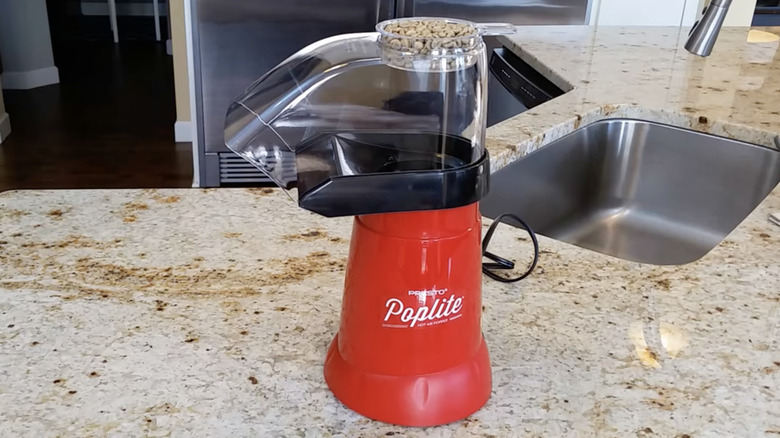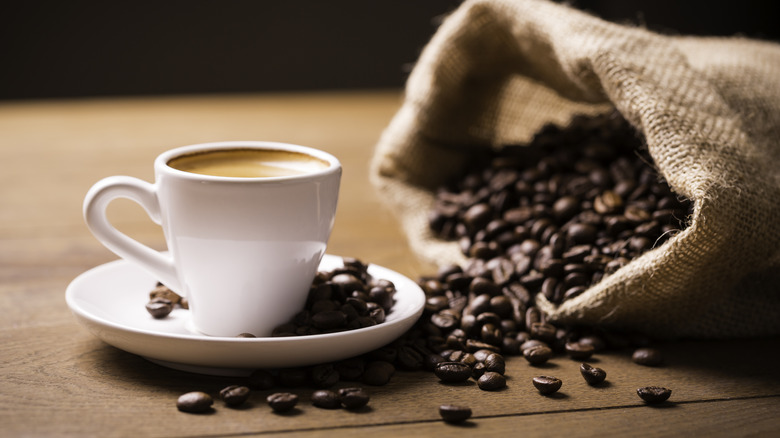The Popcorn Popper Hack To Make A Richer Cup Of Coffee
Nothing compares to the intoxicating aroma of freshly roasted coffee beans. To enjoy this aroma and give your coffee a flavor boost, try roasting your coffee beans at home. The best part is that you don't need a fancy coffee roaster to do so — a simple air popper that you might already have for popping popcorn (or can buy for about $20) will roast your coffee beans in minutes.
Besides that amazing aroma, why would someone want to take the time to roast their coffee beans? One of the best reasons is that it'll save you money since buying green (unroasted) coffee beans is about 50% to 75% cheaper than buying roasted beans. It's also fun to see firsthand the chemical changes the beans undergo as they are roasted.
Roasting coffee beans is what gives them their delicious flavor. Before roasting, they don't have much flavor, beyond a slightly vegetable taste. Chemical changes, such as the Maillard reaction and caramelization, occur as the beans are heated giving them their nutty, sweet, rich flavor. Although it's possible to roast coffee beans on the stove or in the oven, it doesn't circulate the beans enough to roast them evenly.
Air poppers work by circulating hot air, which causes the popcorn kernels to explode or pop. The heating element and fan create a fast-moving vortex of hot air that heats the water inside the kernels. This swirling of hot air also works to evenly and perfectly roast your coffee beans.
How to roast your coffee beans with an air popper
Use the cup that comes with the popper to measure the beans, then turn it on and pour them in. It's helpful to use a utensil to stir the beans every so often. You might lose a few that pop out of the chute, but this should be minimal. At about one minute in, the beans will start to chaff as the flaky outer layer sheds. The chaff will exit through the chute, so it's a good idea to have a bowl there to catch it.
At around two minutes, the beans will start to roast, turning a light brown. Pay attention to the sound. At this point, you'll hear what's known as the first crack in coffee roasting — when the beans reach around 400 degrees Fahrenheit and steam and gases are released. The first cracking sounds you hear will be similar to popcorn popping.
After the first round of cracks, the beans go silent until they heat up to around 450 degrees Fahrenheit, and more gas is released causing the second crack. The second crack occurs around four minutes and is quieter, sounding more like cereal crackling in milk.
How long you let your beans roast depends on your preference for light, medium, or dark roast. The beans are darkly roasted when they go silent after the second crack. Much longer and they could burn. Pour the roasted beans into a colander, stir, and let cool.
Helpful tips for the best roast
The recommended air poppers for roasting coffee have a flat metal bottom, vents on the sides (not on the bottom), and will circulate the coffee. It should also have a chute (where the popcorn comes out) for the chaff from the beans to come out.
You can experiment somewhat with the quantity, but about 1/2 to 3/4 cup of coffee beans is a good place to start. Three-quarters cup of beans yields about 65 ounces of coffee, equal to about eight 8-ounce mugs of coffee. If you use too few beans, they might shoot out of the popper due to too much agitation. In this case, try increasing the quantity slightly.
The messiest part of roasting your coffee beans is the chaff expelling from the popper and the smoke released when you pour the beans into the bowl. Having a bowl to catch the chaff is important for minimizing the mess. Reduce the smoke by placing your air popper on top of a stove with an air vent or setting up your roasting operation outside.
To keep your roasted coffee beans fresh, put them in a resealable bag and remove the excess air. Keep in mind you don't want your coffee to be too fresh — wait at least 24 hours before grinding the beans, allowing them time to degas or emit carbon dioxide. You can also freeze coffee beans in airtight bags or containers to keep them extra fresh.


